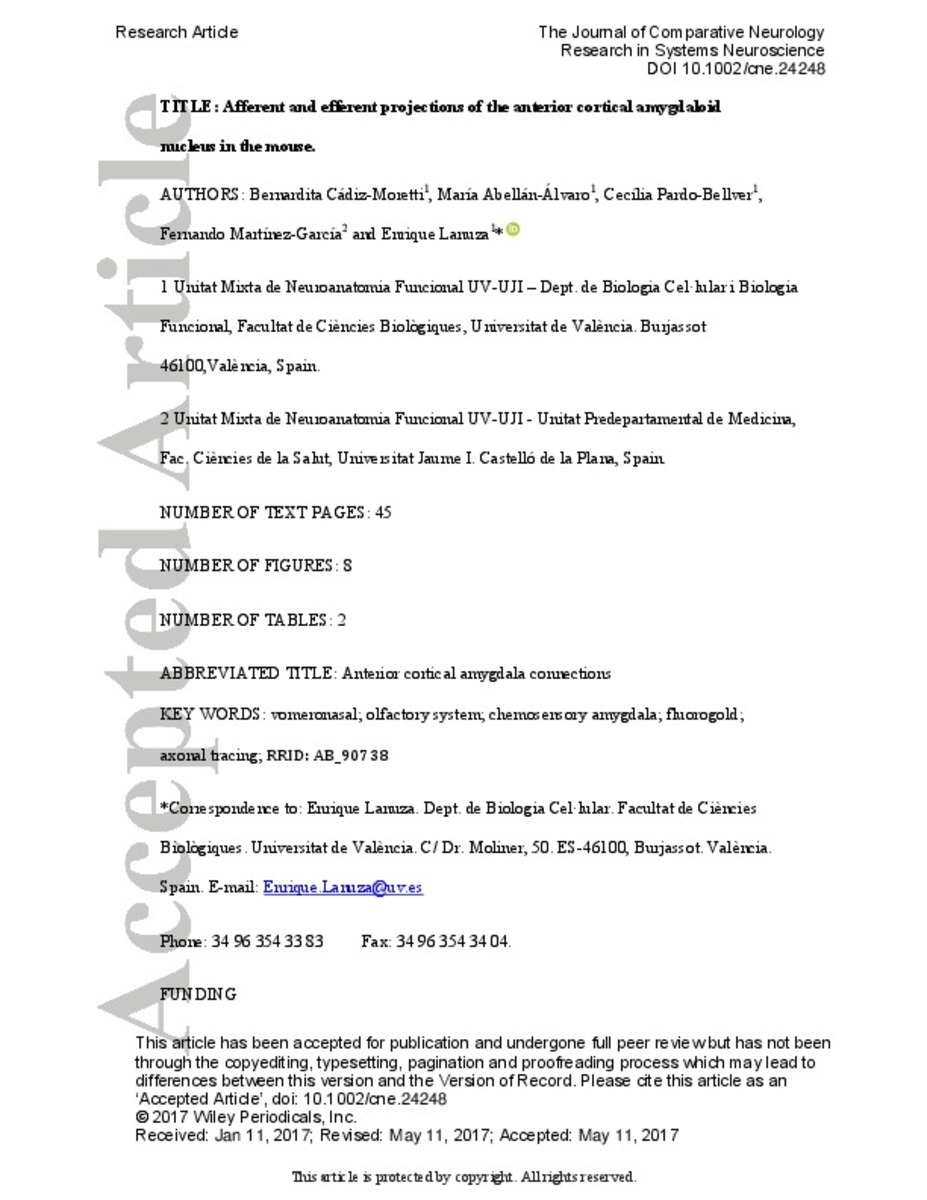Mostrar el registro sencillo del ítem
Afferent and efferent projections of the anterior cortical amygdaloid nucleus in the mouse
| dc.contributor.author | Cádiz-Moretti, Bernardita | |
| dc.contributor.author | Abellán-Álvaro, María | |
| dc.contributor.author | Pardo-Bellver, Cecília | |
| dc.contributor.author | Martinez-Garcia, Fernando | |
| dc.contributor.author | Lanuza, Enrique | |
| dc.date.accessioned | 2017-09-05T07:33:21Z | |
| dc.date.available | 2017-09-05T07:33:21Z | |
| dc.date.issued | 2017-06 | |
| dc.identifier.citation | CÁDIZ‐MORETTI, Bernardita, et al. Afferent and efferent projections of the anterior cortical amygdaloid nucleus in the mouse. Journal of Comparative Neurology, 2017. | ca_CA |
| dc.identifier.uri | http://hdl.handle.net/10234/168563 | |
| dc.description.abstract | The anterior cortical amygdaloid nucleus (ACo) is a chemosensory area of the cortical amygdala that receives afferent projections from both the main and accessory olfactory bulbs. The role of this structure is unknown, partially due to a lack of knowledge of its connectivity. In this work, we describe the pattern of afferent and efferent projections of the ACo by using fluorogold and biotinylated dextranamines as retrograde and anterograde tracers, respectively. The results show that the ACo is reciprocally connected with the olfactory system and basal forebrain, as well as with the chemosensory and basomedial amygdala. In addition, it receives dense projections from the midline and posterior intralaminar thalamus, and moderate projections from the posterior bed nucleus of the stria terminalis, mesocortical structures and the hippocampal formation. Remarkably, the ACo projects moderately to the central nuclei of the amygdala and anterior bed nucleus of the stria terminalis, and densely to the lateral hypothalamus. Finally, minor connections are present with some midbrain and brainstem structures. The afferent projections of the ACo indicate that this nucleus might play a role in emotional learning involving chemosensory stimuli, such as olfactory fear conditioning. The efferent projections confirm this view and, given its direct output to the medial part of the central amygdala and the hypothalamic ‘aggression area’, suggest that the ACo can initiate defensive and aggressive responses elicited by olfactory or, to a lesser extent, vomeronasal stimuli. | ca_CA |
| dc.format.extent | 25 p. | ca_CA |
| dc.format.mimetype | application/pdf | ca_CA |
| dc.language.iso | eng | ca_CA |
| dc.publisher | Wiley | ca_CA |
| dc.rights | Copyright © 2017 John Wiley & Sons, Inc. All Rights Reserved | ca_CA |
| dc.rights.uri | http://rightsstatements.org/vocab/InC/1.0/ | * |
| dc.subject | vomeronasal | ca_CA |
| dc.subject | olfactory system | ca_CA |
| dc.subject | chemosensory amygdala | ca_CA |
| dc.subject | fluorogold | ca_CA |
| dc.subject | axonal tracing | ca_CA |
| dc.title | Afferent and efferent projections of the anterior cortical amygdaloid nucleus in the mouse | ca_CA |
| dc.type | info:eu-repo/semantics/article | ca_CA |
| dc.identifier.doi | https://dx.doi.org/10.1002/cne.24248 | |
| dc.relation.projectID | Funded by the Spanish Ministry of Economy and Competitiveness-FEDER (BFU2013-47688-P; BFU2016-77691-C2-2-P and C2-1-P) and the Generalitat Valenciana (PROMETEO/2016/076). B.C.-M. is a predoctoral fellow of the “Becas Chile” program of the Government of Chile. C.P.-B. is a predoctoral fellow of the “Atracció de Talent” program of the University of València. M.A.-A is a fellow of the “Programa de Empleo Joven” PEJ-2014-A-63220 of the Spanish Government. | ca_CA |
| dc.rights.accessRights | info:eu-repo/semantics/openAccess | ca_CA |
| dc.relation.publisherVersion | http://onlinelibrary.wiley.com/doi/10.1002/cne.24248/full | ca_CA |
| dc.type.version | info:eu-repo/semantics/acceptedVersion | ca_CA |
Ficheros en el ítem
Este ítem aparece en la(s) siguiente(s) colección(ones)
-
MED_Articles [637]
Articles de publicacions periòdiques







